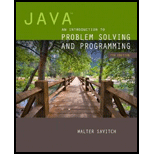
Write a static method blur (double [] [] picture) that you could use on a part of a picture file to obscure a detail such as a person's face or a license plate number. This method computes the weighted averages of the values in picture and returns them in a new two-dimensional array. To find a weighted average of a group of numbers, you count some of them more than others. Thus, you multiply each item by its weight, add these products together, and divide the result by the sum of the weights.
For each element in picture, compute the weighted average of the element and its immediate neighbors. Store the result in a new two-dimensional array in the same position that the element occupies in picture. This new array is the one the method returns.
The neighbors of an element in picture can be above, below, to the left of, and to the right of it, either vertically, horizontally, or diagonally. So each weighted average in the new array will be a combination of up to nine values from the array picture. A corner value will use only four values: itself and three neighbors. An edge value will use only six values: itself and five neighbors. But an interior value will use nine values: itself and eight neighbors. So you will need to treat the corners and edges separately from the other cells.
The weights to use are:
![Chapter 7, Problem 21E, Write a static method blur (double [] [] picture) that you could use on a part of a picture file to , example 1](http://dev-ingestion-image-output.s3-website-us-east-1.amazonaws.com/9780134462035/Chapter-7/images/62035-7-21e-question-digital_image_001.png)
The element itself has the highest weight of 4, the horizontal and vertical neighbors have a weight of 2, and the diagonal neighbors have a weight of 1.
For example, suppose the values in picture are
![Chapter 7, Problem 21E, Write a static method blur (double [] [] picture) that you could use on a part of a picture file to , example 2](http://dev-ingestion-image-output.s3-website-us-east-1.amazonaws.com/9780134462035/Chapter-7/images/62035-7-21e-question-digital_image_002.png)
and the new array is called result. In assigning weights, we will arbitrarily start with an element and consider neighbors in a clockwise direction. Thus, the interior value in result [1] [1] is equal to
To arrive at this equation, we started with the element at picture [1] [1] and then, beginning with the neighbor to the right, we considered neighbors in a clockwise direction. The corner value in result [0] [0] is equal to
Note that picture [0] [0] has fewer neighbors than an interior value such as picture [1] [1]. The same is true for an edge value such as picture [0] [1]. Thus, the edge value in result [0] [1] is equal to
The final array, result, would be
![Chapter 7, Problem 21E, Write a static method blur (double [] [] picture) that you could use on a part of a picture file to , example 3](http://dev-ingestion-image-output.s3-website-us-east-1.amazonaws.com/9780134462035/Chapter-7/images/62035-7-21e-question-digital_image_003.png)
Want to see the full answer?
Check out a sample textbook solution
Chapter 7 Solutions
Java: An Introduction to Problem Solving and Programming plus MyProgrammingLab with Pearson eText -- Access Card Package (7th Edition)
Additional Engineering Textbook Solutions
Elementary Surveying: An Introduction To Geomatics (15th Edition)
Thinking Like an Engineer: An Active Learning Approach (4th Edition)
Starting Out with Java: From Control Structures through Data Structures (4th Edition) (What's New in Computer Science)
Starting Out With Visual Basic (8th Edition)
INTERNATIONAL EDITION---Engineering Mechanics: Statics, 14th edition (SI unit)
- After our initial deployment for our ML home based security system, the first steps we took to contribute further to the project, we conducted load testing, tested and optimize for low latency, and automated user onboarding. What should be next?arrow_forwardWhy investing in skills and technology is a critical factor in the financial management aspect of system projects.arrow_forwardwhy investing in skills and technology is a critical factor in the financial management aspect of systems projects.arrow_forward
 EBK JAVA PROGRAMMINGComputer ScienceISBN:9781337671385Author:FARRELLPublisher:CENGAGE LEARNING - CONSIGNMENT
EBK JAVA PROGRAMMINGComputer ScienceISBN:9781337671385Author:FARRELLPublisher:CENGAGE LEARNING - CONSIGNMENT Microsoft Visual C#Computer ScienceISBN:9781337102100Author:Joyce, Farrell.Publisher:Cengage Learning,Programming Logic & Design ComprehensiveComputer ScienceISBN:9781337669405Author:FARRELLPublisher:Cengage
Microsoft Visual C#Computer ScienceISBN:9781337102100Author:Joyce, Farrell.Publisher:Cengage Learning,Programming Logic & Design ComprehensiveComputer ScienceISBN:9781337669405Author:FARRELLPublisher:Cengage C++ Programming: From Problem Analysis to Program...Computer ScienceISBN:9781337102087Author:D. S. MalikPublisher:Cengage Learning
C++ Programming: From Problem Analysis to Program...Computer ScienceISBN:9781337102087Author:D. S. MalikPublisher:Cengage Learning C++ for Engineers and ScientistsComputer ScienceISBN:9781133187844Author:Bronson, Gary J.Publisher:Course Technology Ptr
C++ for Engineers and ScientistsComputer ScienceISBN:9781133187844Author:Bronson, Gary J.Publisher:Course Technology Ptr EBK JAVA PROGRAMMINGComputer ScienceISBN:9781305480537Author:FARRELLPublisher:CENGAGE LEARNING - CONSIGNMENT
EBK JAVA PROGRAMMINGComputer ScienceISBN:9781305480537Author:FARRELLPublisher:CENGAGE LEARNING - CONSIGNMENT





